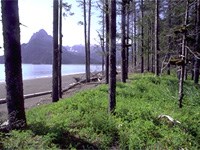 Habitat Enhancement
Habitat Enhancement
The Habitat Enhancement work of the habitat program protects and enhances spill area ecosystems that support EVOS-affected resources and services through active restoration activities. Together with strategic habitat purchases as described further below, these active restoration initiatives address habitat fragmentation and improve access to miles of important fish spawning, rearing and fish and waterfowl migratory habitats and thus support EVOS-affected services such as recreation, subsistence and commercial fishing. Current habitat enhancement projects include initiatives in which multiple state and federal agencies and other partners collaborate on multi-year projects with efficient leveraging of existing agency and third-party resources. These projects often add value to previous EVOSTC investments by improving habitats associated with parcels earlier purchased for their habitat value. Council funding also often stimulates additional funding from other sources. Please see Habitat Enhancement Projects for examples of recent projects funded by the Council.
Habitat Protection
The long-term protection of threatened habitat, considered essential for the well-being of species injured by the oil spill, was one of the earliest goals of the Trustee Council. Restoration efforts in the Pacific Northwest have taught us that habitat protection is essential to the health of salmon species. Researchers have concluded that depleted salmon populations cannot rebuild if habitat that is critical during any of their life stages is seriously compromised. This lesson extends as well to the other fish, birds, and mammals that nest, feed, molt, winter, and seek shelter in the spill area. Habitat protection also supports the restoration of commercial fishing, subsistence, recreation, and tourism, all of which are dependent upon healthy productive ecosystems. Please see Habitat Protection for more information.
